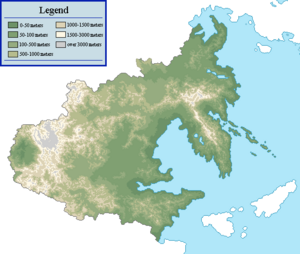Geography of Zhenia
Jump to navigation
Jump to search
 | |
| Continent | Tarsis |
|---|---|
| Region | Themis |
| Area | |
| • Total | 5,423,777.2 km2 (2,094,132.1 sq mi) |
| • Land | 94.34% |
| • Water | 5.66% |
| Borders | Yinguo |
| Highest point | Mount Changjin 8,782.8 m |
| Lowest point | Lake Sagyeong -87 m |
| Longest river | Taimir River 5,429 km |
| Largest lake | Lake Jinsa 6,507.3 km2 |
| Climate | Generally temperate and continental climate, arid/semi-arid in west, alpine tundra in the central-western mountains; monsoon-influenced temperate climate in the central and east coasts, subtropical in the south |
| Terrain | Mountains in center-west and southwest and along the Danguk Peninsula, plains in the center, hills in the south |
| Natural Resources | arable land, coal, iron ore, bauxite, uranium, petroleum, natural gas, rare-earth minerals, timber |
| Environmental Issues | air pollution, water pollution, desertification, deforestation, soil erosion |
Zhenia is a nation located on the eastern coasts of the continent of Tarsis in Themys, primarily facing the Hanmaric Ocean. Zhenian geography shows great physical diversity, ranging from fertile lowlands and foothills found along most of the Golden Arc area, to the semi-arid basins and mountains to the west. Both due to terrain and climate, a vast majority of the nation's population and agricultural potential are focused in the east, particularly near the Gulf of Danguk.
Area
Tectonics
Physical regions
General characteristics
Eastern Zhenia (Danguk Peninsula)
Northern Zhenia
Central Zhenia
Southern Zhenia
Western Zhenia
Climate

Koppen climate map of Zhenia.
